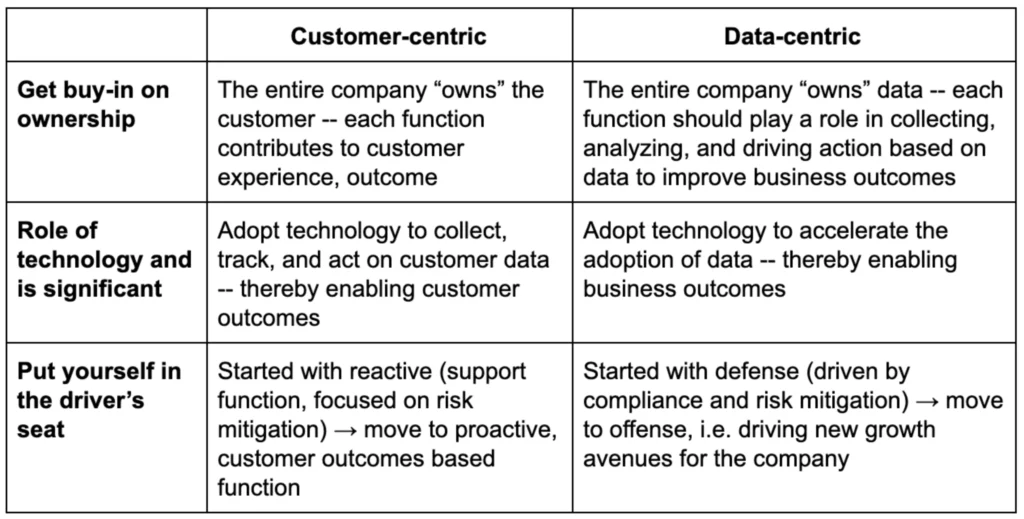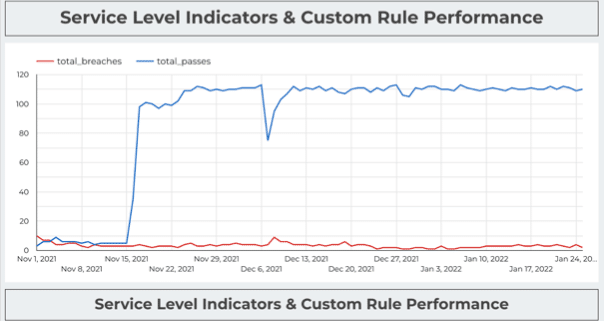You Say You Want a (Data) Revolution

When subscription-based business models started to be all the rage, companies began to realize that being customer-centric is critical for survival — and success. At Gainsight, which helped create and champion the customer success category and where I was the VP of CS Operations, I was fortunate to have a front row seat to this transformation. These days, I am excited to partake in another revolution: As every business becomes a tech business, there’s also an obligation to become data-centric.
I can’t help but draw parallels: Is “data-first” the new “customer-first”? I’ve found it instructive to reflect on these two major business transformations, in the hopes that we can learn from it. Here are three interesting parallels to consider if you want to join the data revolution.

Make customers AND data a company-wide priority
First, consider this: Who in the company “owns” the customer experience? This has almost become a cliche in the customer success space — of course, everyone in the organization does. Every function in the organization contributes to the customer experience and outcome.
But I would posit that in the data space, this question is still open for debate. Who in the company “owns” data? Is it the business consumers of data, focused on turning insight into actions? Or is it those responsible for the infrastructure that generates the volumes of data to work with? I’ve seen answers that vary between the customers, IT, data, engineering, or another department.
If I had to put my money on it, I’d bet that companies are going to converge on a similar answer here: ultimately, everyone in the organization owns the data. It is a shared responsibility among each function to collect, store, analyze and drive actions with data. In a similar vein to customer experience, this is not to say that there isn’t one person accountable for each part of it (and perhaps even a Chief Data Officer to lead the strategy holistically), but collectively it is the entire organization that owns the data and actions based on it — even if at first we might not like that idea.
Adopt technology to accelerate data-driven customer outcomes
In customer success, one of the most critical steps was to figure out how to offload and automate certain tasks, all in the service of focusing on the thing that mattered most: driving value and outcomes for customers. We leveraged software and automation to collect, track, and act on customer data faster and more efficiently — with great results.
One recent example of this is in how TD Ameritrade relies on AI for their “voice of customer” efforts. By applying AI to call center recordings to distill perspective, respond, and tailor recommendations, TD has also been able to free up bandwidth to prioritize broader, customer-first projects. For example, when their analysis showed that customers were calling to get basic information on their investments, TD rolled out a new webpage that gave them the info online. Easy.
Naturally, this customer success example has its roots in data. But the data industry has to look inward with this work, too. For example, cloud-based data warehouses are becoming more prevalent for storing data, offloading an activity — storage — that once may have been viewed as core. But if you think about it, relying on cloud-based warehouses opens up other opportunities for the data team — like adopting other technologies to accelerate innovation. Once the fundamentals are taken care of — like governance, access, quality control, security, and more — then the team can focus on the true innovation that drives customer and business outcomes.
Move from reactive to proactive (aka defense to offense)
At first, customer success was synonymous with a support function. Viewed this way, customer service was often an afterthought, a way to protect your base, with a risk framework to handle inquiries. But about a decade ago, when the SaaS business model gained traction, people began to appreciate that great customer management was more than a defense mechanism. It seems obvious now: Of course great customer prioritization could make customers more successful with your product — and make the business more successful.
It quickly became clear that being proactive in customer success (e.g., build a CS function tasked with driving demonstrable value to customers) was a real growth engine. Today, forward-thinking organizations view customer success as an outcomes-based function that drives growth for the company.
We can draw parallels to the data industry here, too. The data industry by and large started with defense, driven by compliance and risk mitigation. It sat in the IT organization and its skills were primarily applied to detecting issues and figuring out how to stop them before they took stronger hold. But improvements in defense started to hint that there might actually be an opportunity for data to go on the offense, too. It’s starting to become a business-driven, outcome-based, proactive function that drives growth for the company — but we’re still in the early innings here.
All of this is of course a simplification — it is not a 1:1 direct comparison and we should certainly evaluate each situation from first principles. That being said, our collective opportunity — and need — to become customer and data-first organizations has never been more important. Which makes examining how an industry that went before us transformed all the more helpful.
 Product demo.
Product demo.  What is data observability?
What is data observability?  What is a data mesh--and how not to mesh it up
What is a data mesh--and how not to mesh it up  The ULTIMATE Guide To Data Lineage
The ULTIMATE Guide To Data Lineage 





